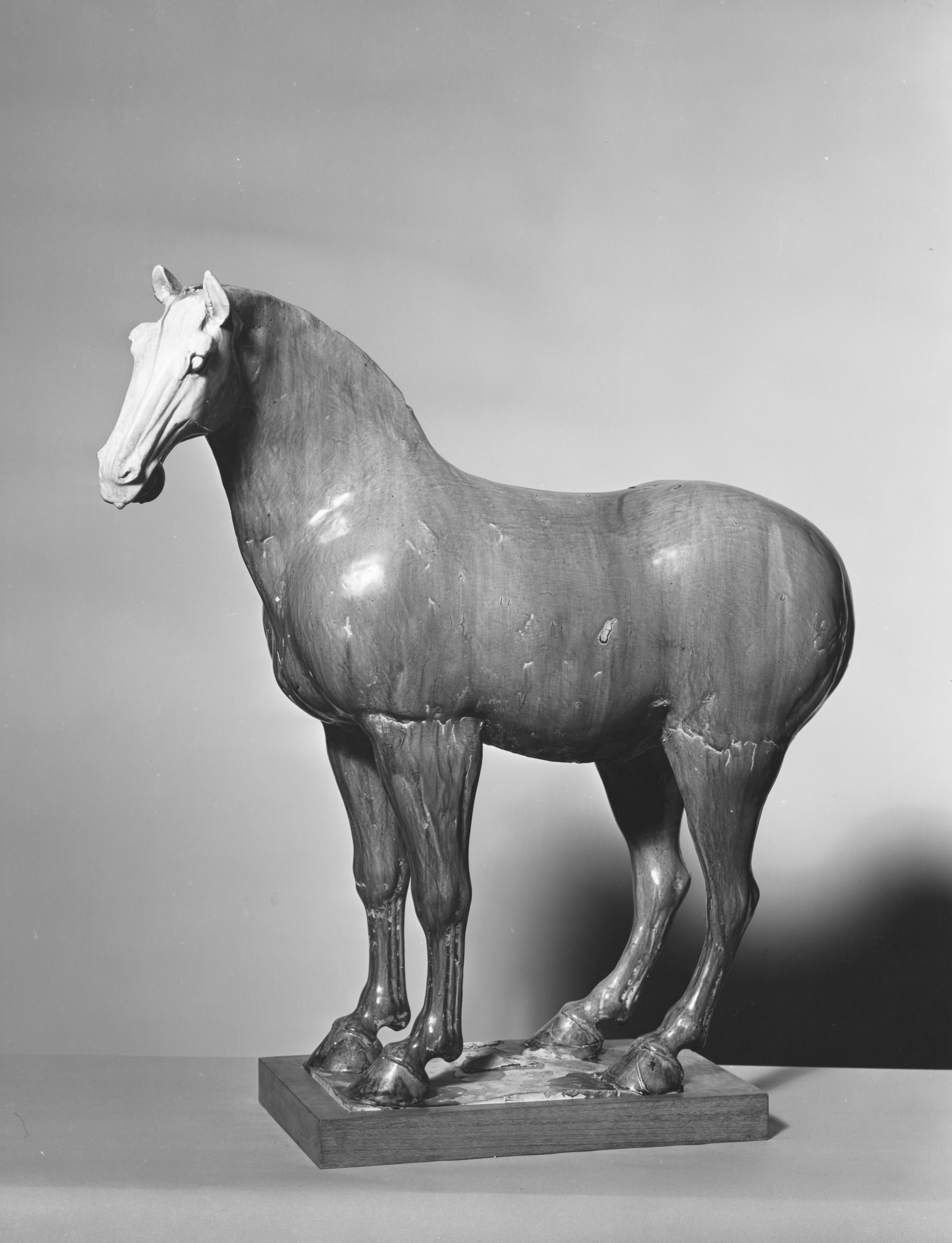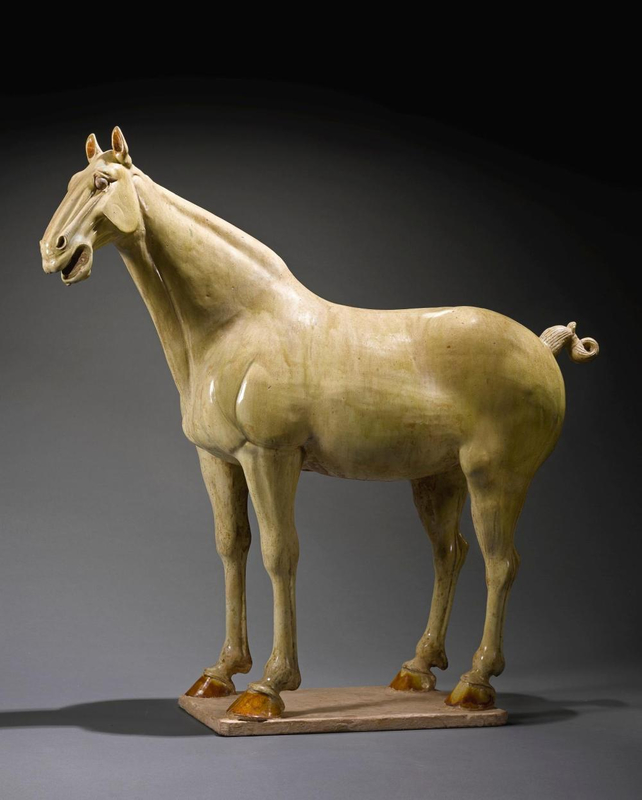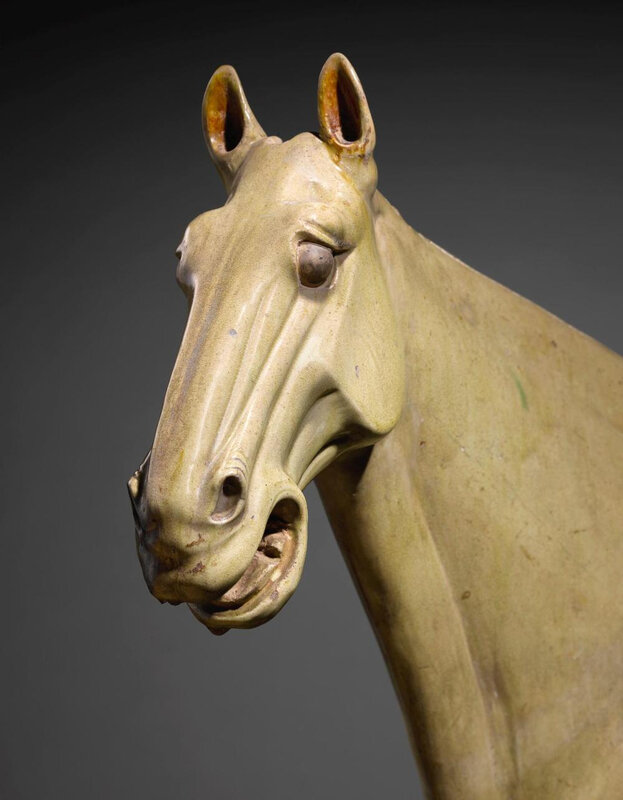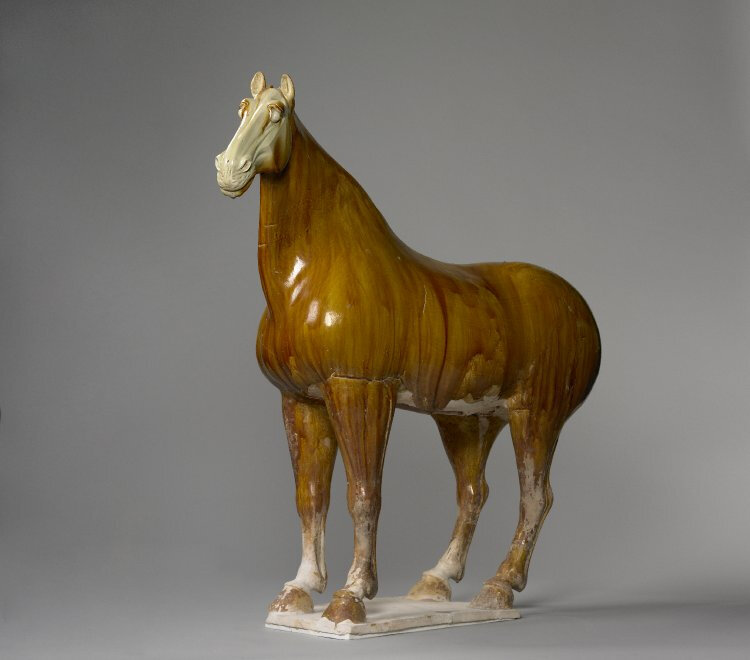Sotheby's. Important Chinese Art. London, 07 nov. 2018, 10:30 AM
A large and impressive glazed pottery horse, Tang dynasty (618-907)
Lot 58. A large and impressive glazed pottery horse, Tang dynasty (618-907); 79.5 cm, 31 1/4 in. Estimate £100,000 - £150,000. © Sotheby's.
the animal standing four square on an unglazed rectangular plinth, the head slightly turned and the proud face naturalistically depicted with unglazed bulging eyes, pronounced jaw bones and flaring nostrils, the anatomy rendered with well-defined muscles and bone structure, covered overall with a pale yellow straw glaze, the hooves in ochre.
Provenance: Purchased at the Biennale des Antiquaires, Paris, in the late 1960s/early 1970s.
Grand in stature and naturalistically modelled, this horse exemplifies the thriving ceramic sculptural tradition of the Tang dynasty (618-907). It was during this period when equine sculpture reached a new artistic peak, when craftsmen were able to capture the confidence and vigour of the horse. Through its bulging eyes, flaring nostrils, pricked ears and pronounced cheek bones, both the spirit and individuality of the animal is meticulously portrayed. Together with the simplicity of the unadorned body and imposing size, the physical appearance of the present figure exudes a sense of tamed power and strength.
One of the 'Six Livestock' in ancient China, the horse was the embodiment of the highest honours as well as transferable markers of wealth. During the Tang dynasty, ownership of horse statues was asserted as an aristocratic privilege in an edict forbidding artisans and tradesmen this right. The representation of a large sculpture of distinctive quality, such as the present example, reflects the high rank and importance of the owner and his family.
Compare a horse of similar size, covered in a yellowish-brown glaze, from the collection of George Eumofopoulos and now in the British Museum, London, illustrated in William Watson, Tang and Liao Ceramic, London, 1984, pl. 220; another, covered in a rich dark-brown glaze, with patches of cream glaze diffused with splashes of green and ochre on the head, neck and haunches, sold in these rooms, 2nd March 1971, lot 92; and a horse excavated in 1965 from Qinan county, Gansu province, illustrated in ‘Gansu qinan xian tangmu qingli jianbao’, Wenwu [Cultural Relics], 1975, no. 4, pl. 4, fig 3. Smaller horses of this type include one covered in a pale yellowish-green glaze, from the collection of Mr and Mrs William Dieterle, exhibited in The Arts of the T'ang Dynasty, Los Angeles County Museum, Los Angeles, 1957, cat. no. 164; and a smaller brown-glazed horse, in the Metropolitan Museum of Art, New York, accession number 51.66.
Horse, Tang dynasty (618-907), Luoyang, 728, sancai ware, from the collection of George Eumofopoulos, 1936,1012.226 © The Trustees of the British Museum.

Horse, 8th century, Tang dynasty (618–907). Earthenware with brown glazes. H. 27 1/8 in. (68.9 cm); L. (base) 27 in. (68.6 cm), Seymour Fund, 1951, 51.66. © 2000–2018 The Metropolitan Museum of Art.

/https%3A%2F%2Fprofilepics.canalblog.com%2Fprofilepics%2F1%2F0%2F100183.jpg)
/https%3A%2F%2Fstorage.canalblog.com%2F03%2F02%2F119589%2F96711876_o.jpg)
/https%3A%2F%2Fstorage.canalblog.com%2F11%2F31%2F119589%2F94773502_o.jpg)
/https%3A%2F%2Fstorage.canalblog.com%2F20%2F83%2F119589%2F94772815_o.jpg)
/https%3A%2F%2Fstorage.canalblog.com%2F26%2F72%2F119589%2F75604929_o.jpg)
/https%3A%2F%2Fstorage.canalblog.com%2F59%2F60%2F119589%2F26458628_o.jpg)





/image%2F1371349%2F20240426%2Fob_dcd32f_telechargement-32.jpg)
/image%2F1371349%2F20240426%2Fob_0d4ec9_telechargement-27.jpg)
/image%2F1371349%2F20240426%2Fob_fa9acd_telechargement-23.jpg)
/image%2F1371349%2F20240426%2Fob_9bd94f_440340918-1658263111610368-58180761217.jpg)